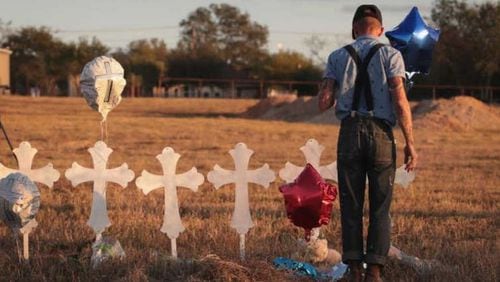The massacre of 26 worshipers at a rural Texas church is the latest in a series of mass shootings across America in recent years.
Each tragedy spurs arguments about gun violence, mental health, how much firearms should be regulated and what’s driving the prevalence of mass shootings. PolitiFact has worked for years to research these topics.
Here are answers to some questions you may have.
How do we define mass shootings?
There is no widely accepted definition. People use either broad or restrictive definitions to reinforce their stance on gun control.
Researchers at the nonpartisan Congressional Research Service defined “mass shooting” as “a multiple homicide incident in which four or more victims are murdered with firearms, within one event, and in one or more locations in close proximity” in a 2015 report. They counted 317 mass shootings from 1999-2013. Sixty-six of them were “mass public shootings,” with four or more victims in one event in a public place.
After the 2012 Sandy Hook school shooting, Congress defined “mass killings” as three or more homicides in a single incident.
The Gun Violence Archive tracks gun deaths using media, law enforcement, government and commercial sources. Its data is based on a broader criteria: at least four people injured or killed in one location, not including the suspect. Criminologists previously told PolitiFact that this group’s tally includes gang shootings and home-invasion robberies.
When is a mass shooting in the United States considered terrorism?
A mass shooting must meet several criteria to be legally labeled domestic terrorism. That definition applies to acts dangerous to human life that violate U.S. or state laws, occur primarily in U.S. territorial jurisdiction and appear to be intended to:
• intimidate or coerce a civilian population;
• influence the policy of a government by intimidation or coercion; or
• affect the conduct of a government by mass destruction, assassination, or kidnapping.
The suspect who plowed his car into a crowd of counterprotesters in Charlottesville, Va., killing a woman, was not charged with terrorism but second-degree murder. Dylann Roof was charged with federal and state crimes, but not domestic terrorism, after shooting nine black churchgoers in Charleston, S.C., in 2015.
However, in the Oct. 31 truck attack on a bicycle path in New York, the suspect was charged with providing material support to a terrorist organization.
How do mass shootings in the U.S. compare to other countries?
Mass shootings happen more often in the United States.
Two researchers — Jaclyn Schildkraut of the State University of New York in Oswego and H. Jaymi Elsass of Texas State University — analyzed mass shootings in 11 countries from 2000-14: the United States, Australia, Canada, China, England, Finland, France, Germany, Mexico, Norway and Switzerland.
The United States has more mass shootings, and more people cumulatively killed or injured, than the other 10 nations combined, according to their research.
When adjusted for population, the United States ranks in the upper half of their list of 11 countries, above Australia, Canada, China, England, France, Germany and Mexico. The United States did rank lower than Norway, Finland and Switzerland but those three countries’ populations so small that one or two mass-casualty events can produce a relatively high per capita rate.
Is a mental health crisis driving mass shootings?
Mental instability is not a good predictor of mass shootings.
A study in the American Journal of Public Health found that databases that track gun homicides show that less than 5 percent of 120,000 gun-related killings in America between 2001 and 2010 were committed by people with a diagnosed mental illness.
The Centers for Disease Control and Prevention reported fluctuations over the years in the number of people who experienced serious psychological distress in the past 30 days. Since 2007, it has ranged from 2.7 percent to 3.8 percent in 2013. In 2015 and 2016, the rate was 3.6 percent.
In the recent Texas church shooting, the killer had a history of mental illness.
One difficulty of turning a link between mental illness and mass shootings into effective public policy is that mass shootings are rare events. Gun violence researchers have found the strongest predictors of violence in general include alcohol,drug abuse and a history of domestic violence.
The Air Force had jailed the Texas shooter for beating his wife and stepson, but failed to pass that information along to the FBI, an apparent breach of Pentagon guidelines.
Are lawmakers bought by the gun lobby?
The National Rifle Association is an influential lobbying group, throwing a lot of money around the political process.
All the NRA’s contributions to candidates, parties and leadership political action committees between 1998 and 2016 come to more than $13 million, according to calculations from the Center for Responsive Politics’ database. Direct contributions are not even close to the biggest part of the NRA spending on policy influence, however.
During that same period, the NRA spent $144.3 million, largely on efforts “expressly advocating the election or defeat of a clearly identified candidate.” These are often campaign ads, but they have to be carried out without coordinating with the candidates they are supporting.
In addition, the NRA has reported spending a cumulative $45.9 million on federal lobbying since 1998.
Added all up, the NRA has spent $203.2 million on political activities since 1998.
Are AR-15s/semiautomatics involved in recent mass shootings?
Yes. Semiautomatic rifles similar to the AR-15 have been used in high-profile and deadly mass shootings over the years in Aurora, Colo.; Roseburg, Ore.; San Bernardino, Calif.; Newtown, Conn.; Orlando; and in 2017, Las Vegas and Sutherland Springs, Texas.
The original AR-15 was a derivative of a rifle first developed by gunmaker ArmaLite in the 1950s. The AR refers to ArmaLite rifle, and does not stand for “assault rifle.” U.S. armed forces use related models of this rifle, usually with automatic capability, which are generally not legal for private citizens to own.
There are somewhere between 6 million and 10 million of these semiautomatic rifles in circulation in the United States.
A gun does not have to be a rifle to be semiautomatic. Many handguns also are semiautomatics, as are numerous models of hunting rifles and shotguns. The killer in the 2007 Virginia Tech shootings killed 32 people with two semiautomatic handguns.
What is the difference between a semiautomatic and automatic?
“Semiautomatic” refers to any firearm designed to fire one bullet with one trigger squeeze, then automatically reload the chamber with a cartridge from a magazine and re-cock the firing mechanism to be ready to fire again.
On automatic weapons, squeezing the trigger fires bullets continually until the shooter releases it. These weapons are often described as machine guns.
While semiautomatic rifles are widely available, fully automatic weapons are not. You can still buy an automatic weapon, but their sale and ownership is highly regulated and exceptionally expensive.
About the Author






